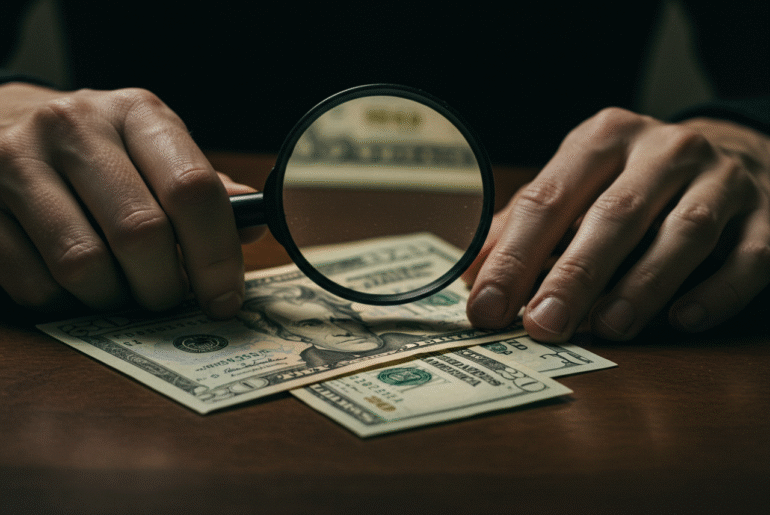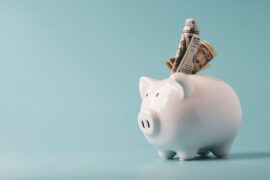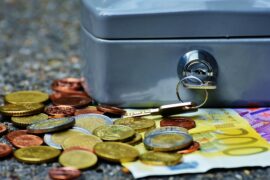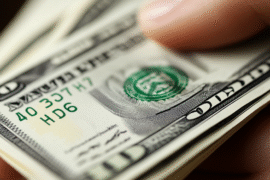This article may contain references to products or services from one or more of our advertisers or partners. We may receive compensation when you click on links to those products or services. Nonetheless, our opinions are our own.
The information presented in this article is accurate to the best of our knowledge at the time of publication. However, information is subject to change, and no guarantees are made about the continued accuracy or completeness of this content after its publication date.
- Bills That Could Be Worth More Than Face Value
- Rare Finds in Your Everyday Cash
- Types of Rare Bills Collectors Want
- How to Assess the Condition of Your Bills
- Where to Sell Your Valuable Bills
- How to Preserve Bill Value Long-Term
- How to Start Collecting and Trading Bills
- Final Thoughts
- Frequently Asked Questions
- Recommended Reads
Bills That Could Be Worth More Than Face Value
Have you ever looked through your wallet and thought about the true value of the bills tucked inside it? While currency is typically recognized for its face value, some bills hold hidden worth that may surprise you. We explore 17 specific types of bills that could be worth more than what they say on the surface. Whether you’re a seasoned collector or just curious about the money you carry, you might find that your wallet contains more than just a means to make a purchase. From rare series to unique serial numbers, knowing what’s in your wallet could lead to an unexpected financial gain.
Rare Finds in Your Everyday Cash
Imagine rifling through your wallet and stumbling upon a bill worth far more than its face value. Many people overlook the potential treasures in their cash, yet certain bills can fetch a surprising premium among collectors. These notes aren’t merely currency; they may hold significant collector value. Here are some examples to watch for:
- Star Notes: Replacement bills printed with a star at the end of their serial number. They are valued for their scarcity.
- Old Series Bills: Currency printed before 1969 can carry a collector’s premium, especially in good condition.
- Misprints: Bills with printing errors can be especially valuable. Look for notes with missing elements or unusual markings.
- Low Serial Numbers: Notes with serial numbers like “00000001” or sequential patterns are highly sought after.
| Bill Type | Value Range |
|---|---|
| Star Note (Common) | $5–$30 |
| Old Series Bill | $10–$1,000+ |
| Rare Misprint | $50–$5,000+ |
By taking a moment to examine the currency in your possession, you may uncover items that turn your wallet into a valuable collection.
Types of Rare Bills Collectors Want
As you sort through your cash, you might encounter bills that hold more than just spending power. Collectors actively pursue specific types of currency with unique features or historical significance. Look for the following characteristics:
- Star Notes: These replace defective bills and are often considered rare.
- Low Serial Numbers: Sequences starting with “00000001” or patterns like “12345678” are collectible.
- Misprints: Errors such as double prints or missing details increase value significantly.
- Historical Series: Notes from notable periods, such as wartime issues, draw collector attention.
| Bill Type | Face Value | Estimated Collector Value |
|---|---|---|
| Star Note | $1 | $10+ |
| Low Serial Number | $5 | $50+ |
| Misprint | $10 | $100+ |
| Series 1934A | $20 | $250+ |
Spotting these traits could open the door to surprising opportunities and turn everyday currency into something more.
How to Assess the Condition of Your Bills
Condition plays a critical role in determining a bill’s value. Even a rare note may lose its appeal if it’s torn, stained, or heavily used. Here are some factors to evaluate:
- Wear and Tear: Look for folds, creases, or discoloration. Crisp, uncirculated notes are most valuable.
- Color and Ink Quality: Vibrant color and even printing add value. Faded ink or smudging lowers it.
- Serial Number Visibility: Clarity and uniqueness of the serial number enhance appeal.
| Bill Denomination | Condition | Estimated Value |
|---|---|---|
| $5 | Very Good | $6 |
| $10 | Good | $12 |
| $20 | New | $25 |
Understanding a bill’s condition gives you an advantage when deciding whether to keep, trade, or sell.
Voted "Best Overall Budgeting App" by Forbes and WSJ
Monarch Money helps you budget, track spending, set goals, and plan your financial future—all in one app.
Get 50% OFF your first year with code MONARCHVIP
Where to Sell Your Valuable Bills
If you’ve identified valuable bills, consider where to sell them for the best return. Start with local coin and currency dealers. These professionals can appraise your notes and may offer to purchase them directly. For a broader market, online platforms offer greater reach:
- eBay: Offers a large audience and auction format.
- Heritage Auctions: Best for high-value notes with a targeted collector base.
- Local Dealers: Provide personalized service and quick transactions.
Before listing your bills, follow this checklist:
- Research current value using online guides or auction histories.
- Take clear, high-resolution photos showing all relevant details.
- Write a detailed description, including any notable serial numbers or conditions.
| Platform | Pros | Cons |
|---|---|---|
| eBay | Wide reach; auction options | Seller fees; competition |
| Local Dealers | Fast transaction; expert knowledge | Possibly lower offers |
| Heritage Auctions | Specialized audience; high-value sales | Longer sale process; fees |
Preparation is important to a successful transaction.
How to Preserve Bill Value Long-Term
To protect your valuable bills, proper storage is necessary. Keep currency in a cool, dry environment, away from sunlight or humidity. Use acid-free sleeves or holders to prevent wear while allowing safe display. Educating family members about the importance of these bills can help preserve their value long-term. Consider keeping a record of:
- Purchase price
- Current condition
- Estimated market value
| Bill Type | Condition | Market Value |
|---|---|---|
| 1907 $20 Gold Certificate | Very Fine | $2,500 |
| 1950 $10 Silver Certificate | Uncirculated | $150 |
| 2003 $5 Star Note | Fine | $25 |
This documentation can provide both historical and financial context for future owners.
How to Start Collecting and Trading Bills
Creating a bill collection can be rewarding both emotionally and financially. If you’re just starting, focus on identifying bills with these characteristics:
- Misprints and Errors: Printing mistakes that increase collector value.
- Star Notes: Less common replacement notes.
- Older Series: Bills from the early to mid-20th century or earlier.
- Low Serial Numbers: Especially those starting with “00000001.”
| Bill Type | Estimated Value |
|---|---|
| Star Note | $25–$300+ |
| Misprinted Bill | $50–$1,000+ |
| Old Series (e.g., 1928) | $100–$1,500+ |
| Low Serial Number | $200–$10,000+ |
Engaging with the collector community can help you discover new insights and opportunities as your collection grows.
Final Thoughts
Your wallet may hold more than just spending power; it could contain genuine collector gems. From rare serial numbers to bills with historical significance, a closer look at your cash might reveal unexpected value. With proper evaluation, storage, and market knowledge, you can turn everyday currency into a valuable asset. Stay informed and curious, and you might uncover hidden treasures in the most unlikely place: your own wallet.
Frequently Asked Questions
What are bills worth more than their face value?
Certain bills can have collectible value due to rarity, misprints, or historical context. Collectors often seek out notes with unusual features like printing errors, low serial numbers, or special historical significance. These traits can raise a bill’s market value significantly. Even a $1 bill could be worth hundreds under the right conditions.
How can I identify valuable bills?
Look for unique serial numbers, printing errors, or bills from older series. Star notes and misprinted bills often fetch higher values. Pay attention to the overall condition, and cross-reference your bills with online guides. Having your note appraised can also confirm its worth.
What types of bills are considered collectible?
Examples include silver and gold certificates, star notes, and bills from rare series like 1896 or 1928. Notes with historical significance or that were printed in smaller quantities are particularly desirable. Bills featuring errors or with artistic appeal may also hold value. Collectors vary in what they seek, so demand can fluctuate.
What is the significance of serial numbers?
Patterns like “00000001” or “12345678” are considered rare and may command higher values. Repeating or palindrome numbers also have collector interest. The more unique the serial number, the higher the premium it might attract. Always check both condition and serial to gauge value.
Are old bills more valuable than new ones?
Generally, yes, especially if they are uncirculated or part of a rare print run. Age can add to the appeal, particularly if the bill is tied to historical events or printing styles. However, condition remains vital even with older notes. Some newer bills with rare traits may also be valuable.

Reviewed and edited by Albert Fang.
See a typo or want to suggest an edit/revision to the content? Use the contact us form to provide feedback.
At FangWallet, we value editorial integrity and open collaboration in curating quality content for readers to enjoy. Much appreciated for the assist.
Did you like our article and find it insightful? We encourage sharing the article link with family and friends to benefit as well - better yet, sharing on social media. Thank you for the support! 🍉
Article Title: Hidden Cash: Bills Worth More Than Face Value
https://fangwallet.com/2025/07/31/hidden-cash-bills-worth-more-than-face-value/The FangWallet Promise
FangWallet is an editorially independent resource - founded on breaking down challenging financial concepts for anyone to understand since 2014. While we adhere to editorial integrity, note that this post may contain references to products from our partners.
The FangWallet promise is always to have your best interest in mind and be transparent and honest about the financial picture.
Become an Insider

Subscribe to get a free daily budget planner printable to help get your money on track!
Make passive money the right way. No spam.
Editorial Disclaimer: The editorial content on this page is not provided by any of the companies mentioned. The opinions expressed here are the author's alone.
The content of this website is for informational purposes only and does not represent investment advice, or an offer or solicitation to buy or sell any security, investment, or product. Investors are encouraged to do their own due diligence, and, if necessary, consult professional advising before making any investment decisions. Investing involves a high degree of risk, and financial losses may occur including the potential loss of principal.
Source Citation References:
+ Inspo
There are no additional citations or references to note for this article at this time.












































